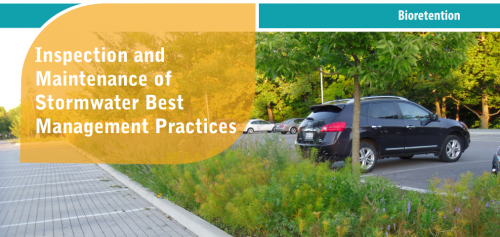Inspection and Maintenance: Bioretention & Bioswales

Overview[edit]
Bioretention treats stormwater by slowing it down, filtering it through soil and plant roots, soaking it into the ground and evaporating it back to the atmosphere. Runoff water is delivered to the practice through inlets such as curb cuts, spillways or other concrete structures, sheet flow from pavement edges, or pipes connected to catchbasins or roof downspouts. The planting bed and side slopes are typically covered with a mixture of plants, mulch and stone. Water in excess of its storage capacity overflows to another BMP or the municipal storm sewer. Filtered water is either infiltrated into the underlying soil to replenish groundwater, or collected by a sub-drain (i.e., underground perforated pipe) and discharged to the storm sewer system or another BMP. Depending on the permeability of the underlying soil or other constraints, it may be designed with no sub-drain for full infiltration, with a sub-drain for partial infiltration, or with an impermeable liner and sub-drain for a no infiltration practice. The sub-drain pipe may feature a flow restrictor (e.g., orifice cap or valve) for gradually releasing detained water and optimizing the amount drained by infiltration. Key components of bioretention practices for inspection and maintenance described further below.
Associated Terminology[edit]
- Bioretention cell: A flat-bottomed, depressed planting bed containing filter media soil, a gravel water storage layer and optional sub-drain pipe(s); Also known as a rain garden.
- Stormwater planters: A bioretention cell contained within an engineered (e.g., concrete) structure.
- Biofilter: Bioretention cell or swale with an impermeable liner or containment structure and sub-drain.
- Dry swale or Bioretention swale: A gently sloping, linear oriented bioretention practice designed to be capable of conveying water across an elevation gradient. Also known as a bioswale or dry swale.
How to Preserve Basic BMP Function[edit]
- Maintain grading of the filter bed (or grass filter strip if present) at curb cut inlets so at least 5 cm of the back of the curb is visible through regular sediment removal and regrading.
- To avoid over-compaction of the filter media soil, any maintenance tasks involving vehicle or foot traffic on the filter bed should not be performed during wet weather.
- For bioretention with sod (i.e., turf grass) as vegetation cover, maintain with a push mower or the lightest mulching ride mower available and core aerate and dethatch annually in the spring to help maintain permeability.
- Pruning of mature trees should be performed under the guidance of a Certified Arborist.
- Woody vegetation should not be planted or allowed to become established where snow will be piled/stored during Winter.
- Removal of sediment from the filter bed surface should be done with rake and shovel, or vacuum equipment to minimize plant disturbance. If a small excavator is to be used, keep it off the BMP footprint to avoid damage to side slopes/embankments and over-compaction of the filter media.
References[edit]
- ↑ TRCA. 2016. Fact Sheet - Inspection and Maintenance of Stormwater Best Management Practices: Bioretention. https://sustainabletechnologies.ca/app/uploads/2018/02/Bioretention-and-Dry-Swales-Fact-Sheet.pdf